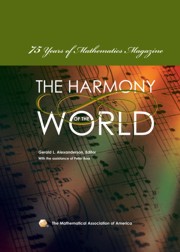Book contents
- Frontmatter
- Introduction
- Contents
- A Brief History of Mathematics Magazine
- Part I The First Fifteen Years
- Part II The 1940s
- Part III The 1950s
- Part IV The 1960s
- Part V The 1970s
- Trigonometric Identities
- A Property of 70
- Hamilton's Discovery of Quaternions
- Geometric Extremum Problems
- Pólya's Enumeration Theorem by Example
- Logic from A to G
- Tiling the Plane with Congruent Pentagons
- Unstable Polyhedral Structures
- Part VI The 1980s
- Briefly Noted
- The Problem Section
- Index
- About the Editors
Logic from A to G
from Part V - The 1970s
- Frontmatter
- Introduction
- Contents
- A Brief History of Mathematics Magazine
- Part I The First Fifteen Years
- Part II The 1940s
- Part III The 1950s
- Part IV The 1960s
- Part V The 1970s
- Trigonometric Identities
- A Property of 70
- Hamilton's Discovery of Quaternions
- Geometric Extremum Problems
- Pólya's Enumeration Theorem by Example
- Logic from A to G
- Tiling the Plane with Congruent Pentagons
- Unstable Polyhedral Structures
- Part VI The 1980s
- Briefly Noted
- The Problem Section
- Index
- About the Editors
Summary
Editors' Note: Paul R. Halmos was one of the great mathematical expositors of our time. Born in Hungary he came to the United States at age 13. He grew up in Chicago and took all of his degrees at the University of Illinois at Champaign-Urbana, where he received his PhD in 1938 under the direction of Joseph Doob. He then moved to the Institute for Advanced Study in Princeton where he was assistant to John von Neumann. He taught at Syracuse University, the University of Chicago (during the famous “Stone Age”), the University of Michigan at Ann Arbor, the University of Hawaii, the University of California at Santa Barbara, Indiana University at Bloomington, and Santa Clara University, from which he retired in 1995.
Many students learned their linear algebra from his Finite-Dimensional Vector Spaces (Van Nostrand, 1942; Springer, 1974). Others remember fondly his Measure Theory (Van Nostrand, 1950; Springer, 1974), Naive Set Theory (Van Nostrand, 1960; Springer, 1974), and his Hilbert Space Problem Book (Van Nostrand, 1967; Springer, 1974, 1982). The MAA has available in its catalogue his I Want To Be a Mathematician/An Automathography (1985), Problems for Mathematicians Young and Old (1991); Linear Algebra Problem Book (1995); and, with Steven Givant, Logic as Algebra (1998). In all he wrote over 120 papers, 25 reviews, and 17 books. Besides his writing on a great variety of topics—his fields of research included operator theory, ergodic theory, and algebraic logic—he often wrote about how to write.
- Type
- Chapter
- Information
- Harmony of the World75 Years of Mathematics Magazine, pp. 169 - 174Publisher: Mathematical Association of AmericaPrint publication year: 2007

